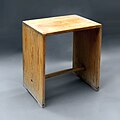Hans Gugelot
Hans Gugelot | |
|---|---|
| Born | Johan Gugelot 1 April 1920 |
| Died | 10 September 1965(aged 45) Ulm,Germany |
| Education | ETH Zurich |
| Parent | Pieter Cornelis Gugelot |

Hans Gugelot(1 April 1920 – 10 September 1965) was an Indonesian-born, German engineer andindustrial designerknown for his modernist consumer products.[1][2]
Life and work
[edit]This sectionneeds expansion.You can help byadding to it.(April 2019) |
Johan Gugelot was born on 1 April 1920 inMakassar,Dutch East Indiesto Dutch parents.[3]
He completed his early education inLarenandHilversum,North Holland.
In 1934, the Gugelot family moved toDavos,Switzerlandfor Hans's father's job as a physician.
Between 1940 and 1942 Gugelot studied architecture in Lausanne, and graduated as an architect fromEidgenössische Technische Hochschule(ETH),Zurichin 1946.
Until 1948 he worked as an architect for a number of architects.[4]In 1947, he married.[specify]
In 1948, Gugelot was hired byMax Bill,for whom he created his first furniture designs.[4][5]
In 1950 he founded his own office and began work on the design of the "M125" shelving and storage system for Bofinger, a product for which he later became known.
Gugelot is closely identified withHochschüle für Gestaltung(HfG) inUlm,Germany.[2]Another influential work of his from this period is the "Ulm Stool",which he designed in collaboration with Max Bill.[3]
In 1954, Gugelot metErwin Braun,then-head of German consumer product company,Braun.Throughout the remainder of the decade, he created a number of designs for the company such as theBraun SK 4radiogram(known as "Snow White's Coffin" ),[6]which he designed withDieter RamsandHerbert Lindinger.[7][4][3]
He also designed aslide projector(the Carousel-S, a professional model sold only in Germany) forKodakin 1962.[2]The design is held in the collection of theMuseum of Modern Art(MoMA), in New York.[8]
Gallery
[edit]- Notable works
-
Ulm Stool (1954)
-
Braun SM 2 shaver (1963)
-
SK 4/10 "Snow White's Coffin" Radio-Phonograph for Braun (1956)
-
Braun turntable
-
M125 storage system (1956)
-
M125 system (details)
References
[edit]- ^"Hans Gugelot - Lebenslauf".www.hansgugelot.com.Archived fromthe originalon 2021-02-26.Retrieved2019-04-07.
- ^abc"Hans Gugelot - Oxford Reference".www.oxfordreference.com.Retrieved2019-04-07.
- ^abc"KulturPortal Frankfurt: Persons".www.kultur-frankfurt.de.Retrieved2019-04-16.
- ^abcWICHMANN (2013-12-14).System-Design Bahnbrecher: Hans Gugelot 1920–65(in German). Springer-Verlag. p. 10.ISBN9783034860314.
- ^"Hans Gugelot – Biografien – eMuseum Museum für Gestaltung Zürich Archiv Zürcher Hochschule der Künste ZHdK".www.emuseum.ch(in German).Retrieved2019-04-16.
- ^"Master and commandments".Wallpaper(103). IPC Media: 321. October 2007.ISSN1364-4475.OCLC948263254.
the Phonosuper SK4, dubbed 'Snow White coffin' because of its transparent lid and white metal casing. The SK4 was revolutionary. Perhaps more than any other product, it marked the end of chunky, bourgeois household electrical products decoratively disguised as pieces of furniture
- ^"A History of Braun Design, Part 3: Audio Products".Core77.Retrieved2023-01-27.
- ^"Hans Gugelot, Reinhold Häcker. Carousel-S Slide Projector. 1963 | MoMA".The Museum of Modern Art.Retrieved2023-01-16.
Further reading
[edit]- Fiell, Charlotte; Fiell, Peter (2005).Design of the 20th Century(25th anniversary ed.). Köln: Taschen. pp. 308–309.ISBN9783822840788.OCLC809539744.






